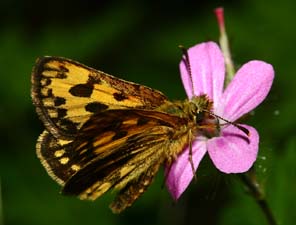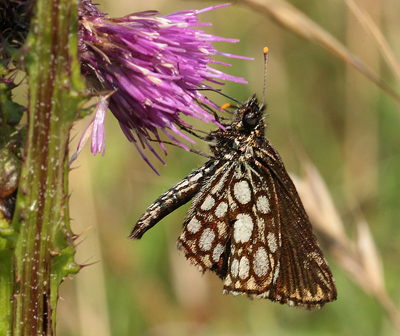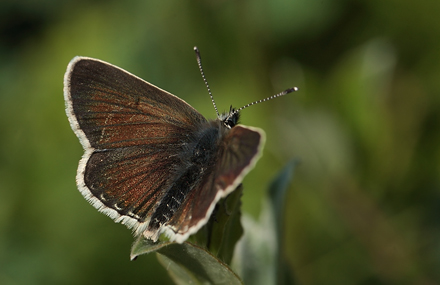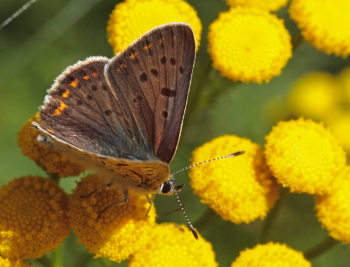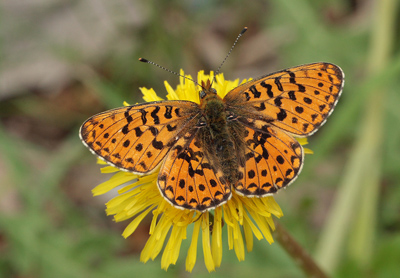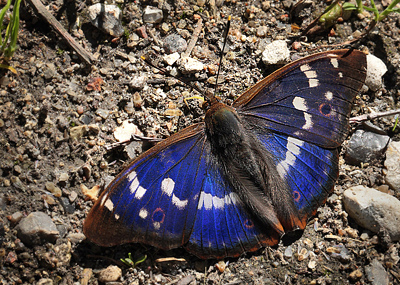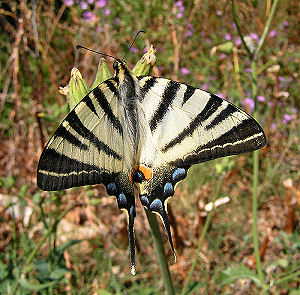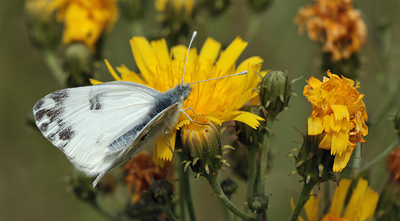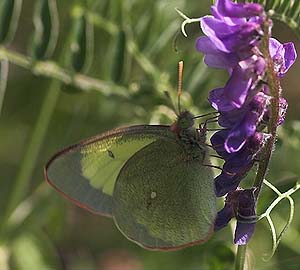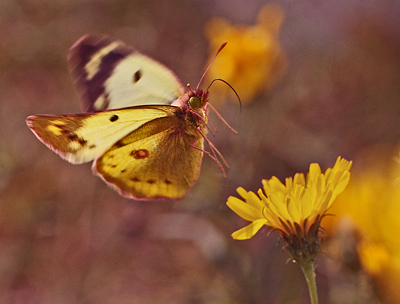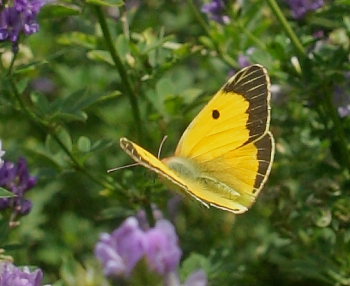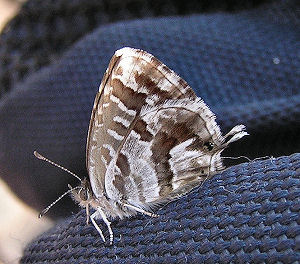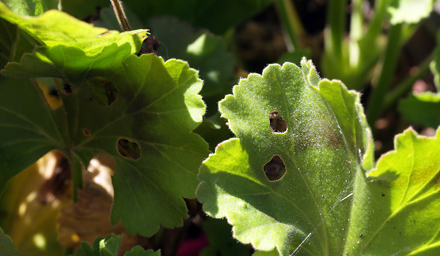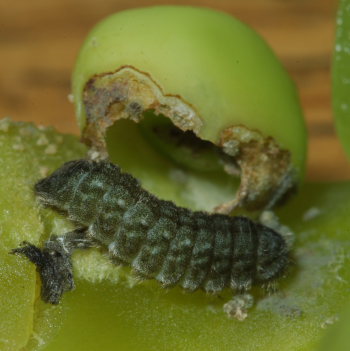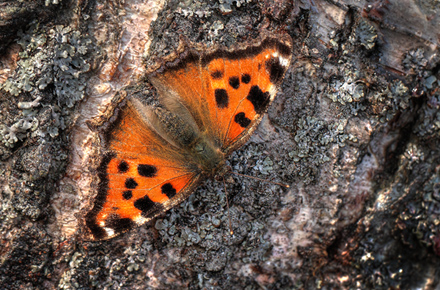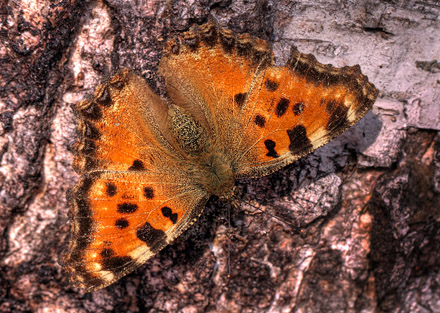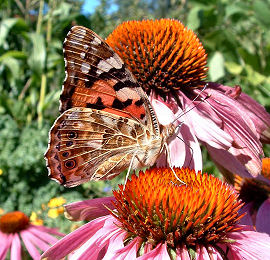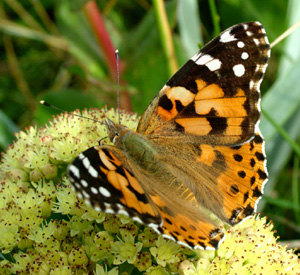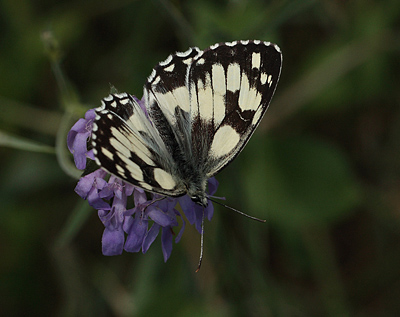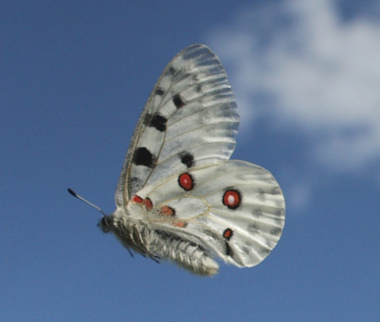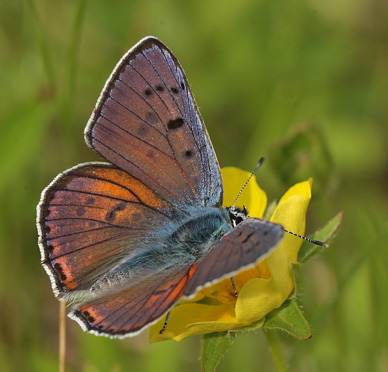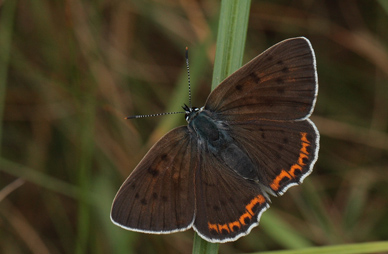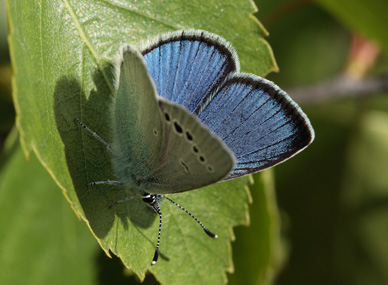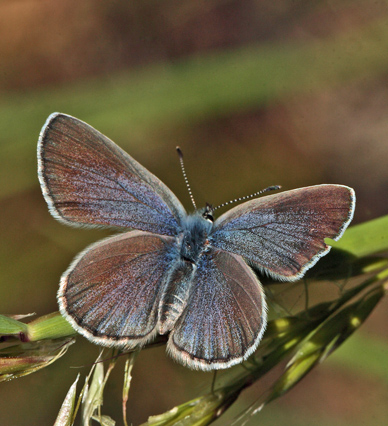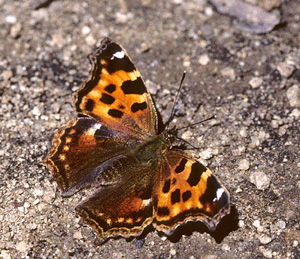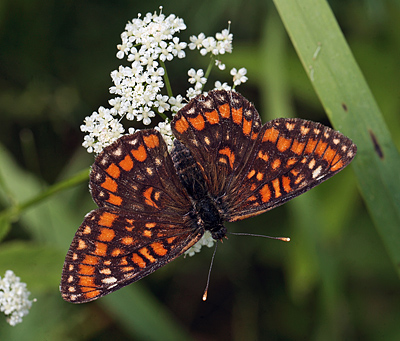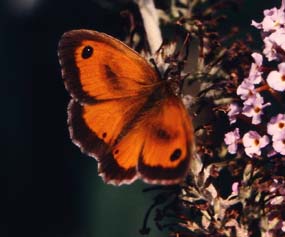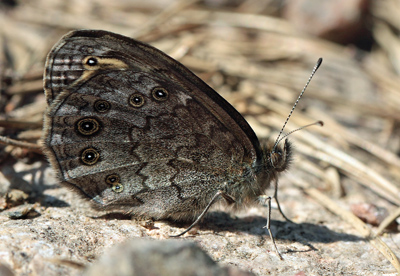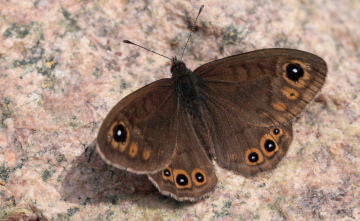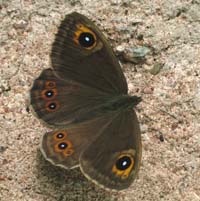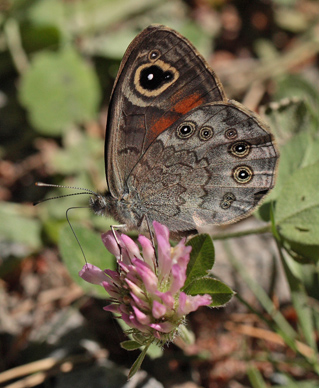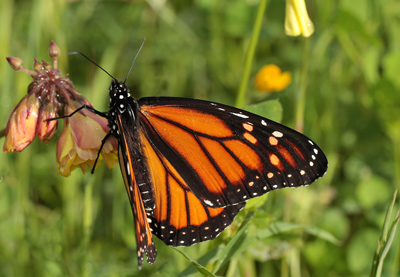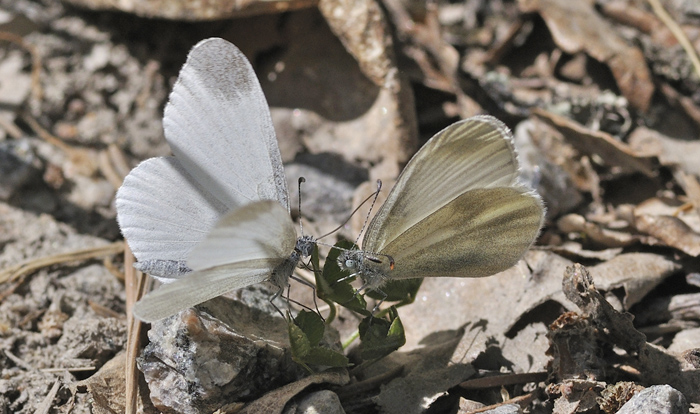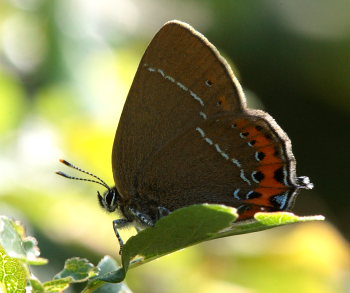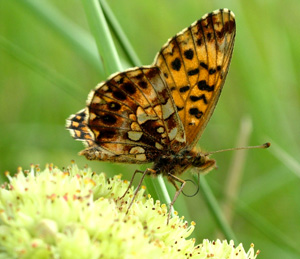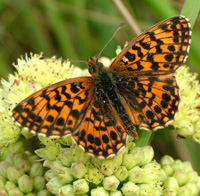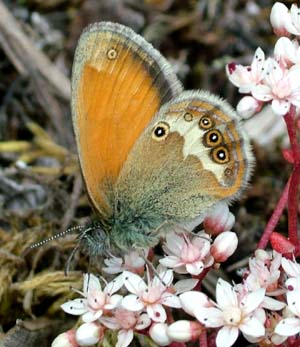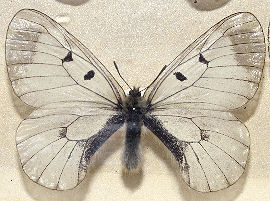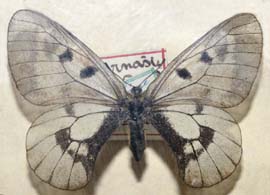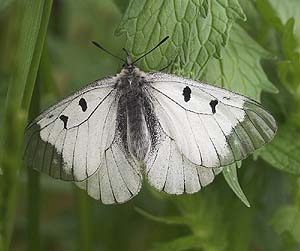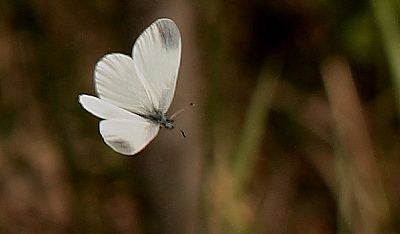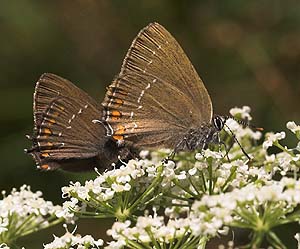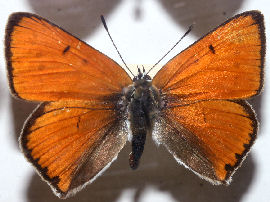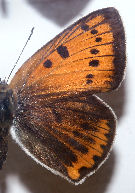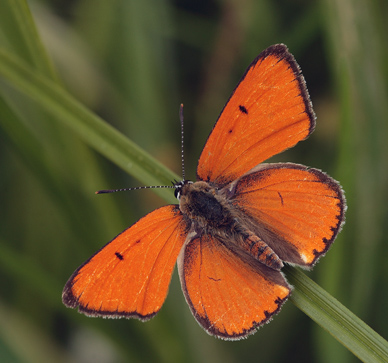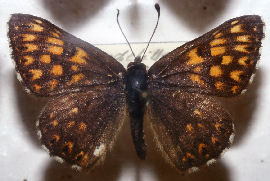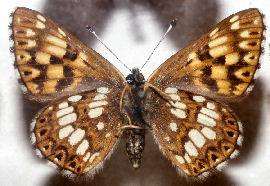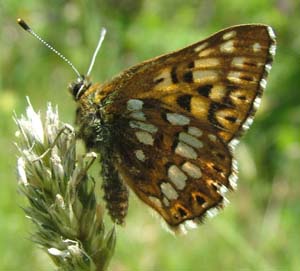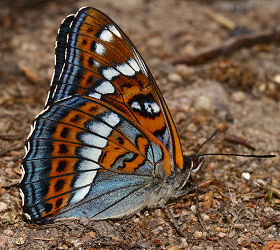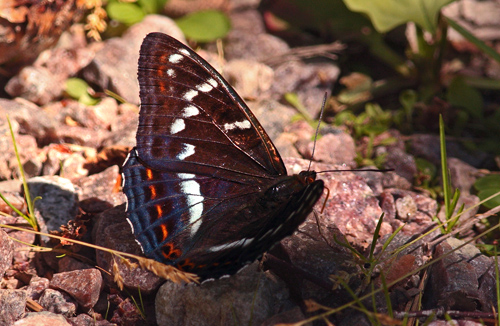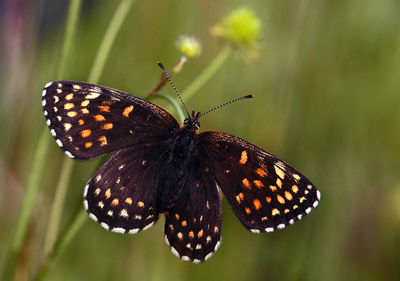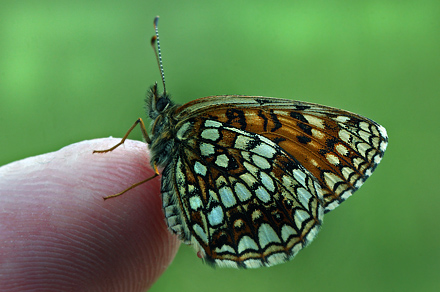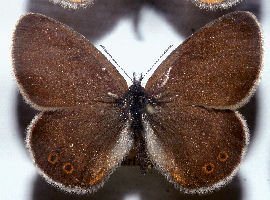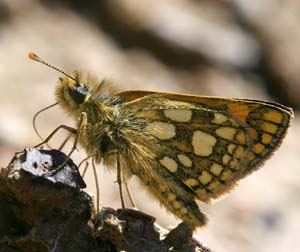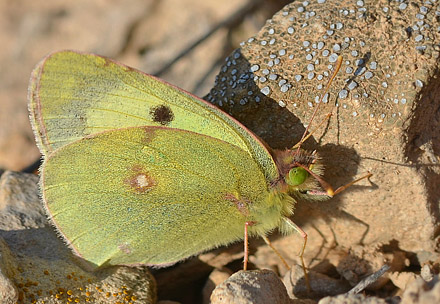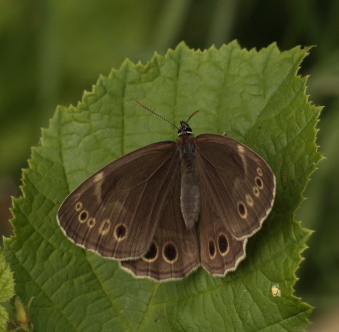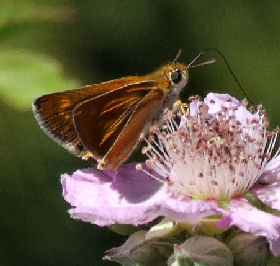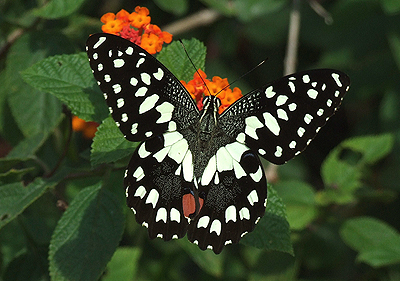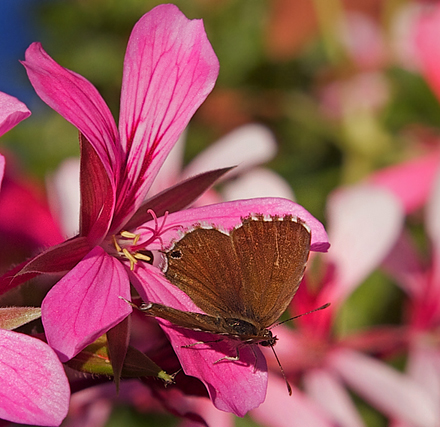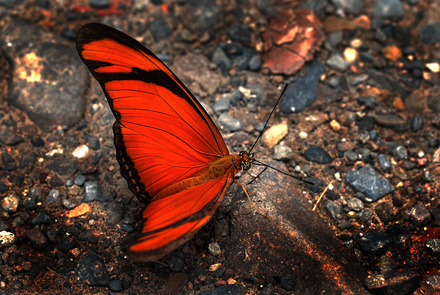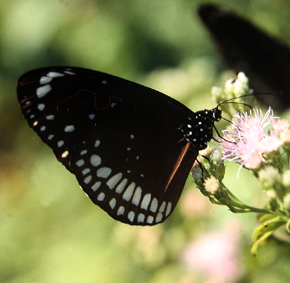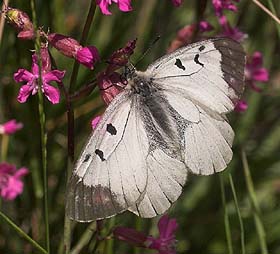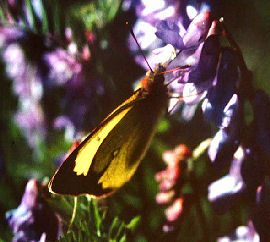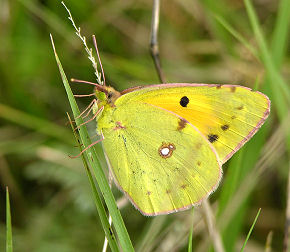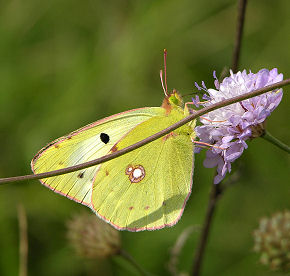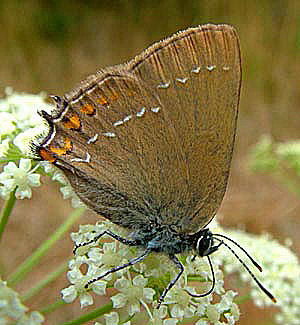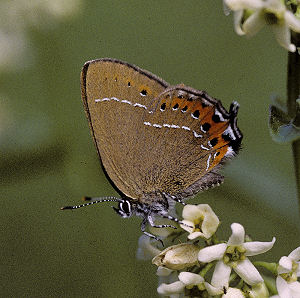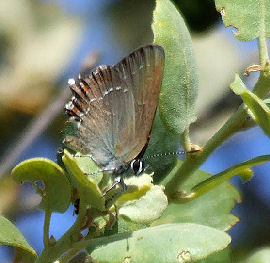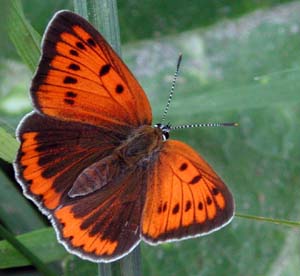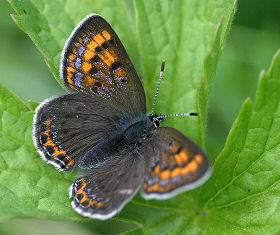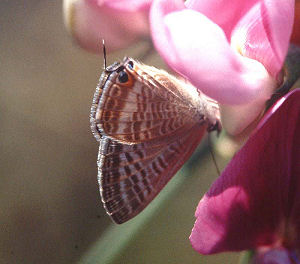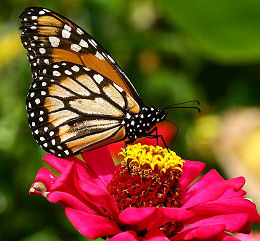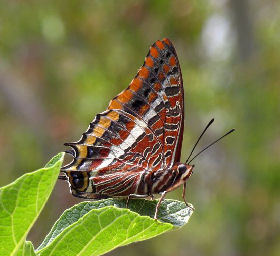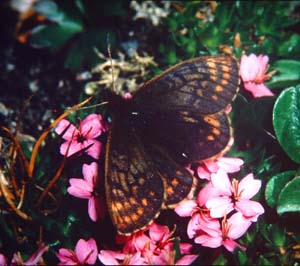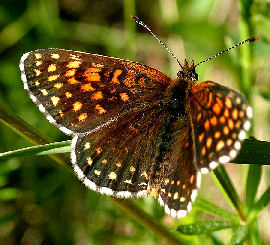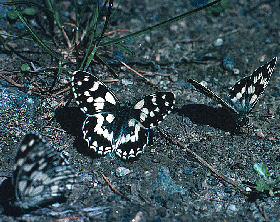Butterflies are rare, immigrants or extinct in Denmark
first update d. 19 January 2014
last update d. 9 October 2018
Rare resident butterflies species in Denmark Oberthur's Grizzled Skipper, Pyrgus armoricanus is one of Denmark's rarest butterflies, and is only available on the western Zealand on Røsnæs. Store Vrøj by Saltbæk Vig, Kalkred / Kalundborg Airfield & 2 locations on Vesterlyng. Northern Chequered Skipper, Carterocephalus silvicola located in Hydeskov, Hamburg Skov & Storskov v. Søholt south of Maribo lakes in the Eastern Lolland. It has been more prevalent on Lolland and Falster. Large Chequered Skipper, Heteropterus morpheus is re-colonized in 2010, now there are two populations in eastern Falster. Perhaps there is also a neglected population at Møn? Large Blue, Maculinea arion are now only back on Høvbleget, Møn where there is a nature conservation of the hilly grassland, concerning the population of Large Blue and orchids. There is also trying to re-introduction of Large Blue in Jydeleje, Møn. Mountain Argus, Aricia artaxerxes found in northwestern Vendsyssel around Hirtshals, from Lønstrup Strand to Skiveren where it is locally numerous. Sooty Copper, Lycaena tityrus was found in Hannenov Skov in 1998, but it has disappeared from again in 2000†. Now, in 1999, discovered a small colony on South Falster which has established several small colonies from Gedesby to Marielyst Dige. Have otherwise disappeared from Denmark where it was in Svanninge Bakker 1986 † of southern Fyn. Pearl-bordered Fritillary, Boloria euphrosyne there are still a few populations in the forests around Køge, Fakse, Præstø and Ringsted in Central and South Zealand and Lolland and Falster, approximately a total of 10 -12 localities in 2012. Which at only 2 localities have meta-populations, are very close to disappearing from Denmark! Lesser Purple Emperor, Apatura ilia have immigrated to the Pinseskoven on Vestamager in 2011, where it has since established themselves. There also observed 1 pc he Fasanskoven 2012 and 1 pc. he Amager Fælled in 2013. Immigrants in Denmark since 1995 Swallowtail, Papilio machaon seen as a rare visitor in May, June and hot August days when the wind has blown from the south and east. Previously, there it firmly in Denmark, and was common in Jutland. But in the 50s it began to disappear, the channelization of streams and more efficient farming pressed it away, the last permanent population in Denmark disappeared from Filsø at Henne Strand in 1978 †. Scarce Swallowtail, Iphiclides podalirius is a relative of Swallowtail, which is seen as a rare visitor in Denmark. Last time on Bøtø Diget, Falster by John Faldborg on August 18, 2012? In 1997, on Bornholm and in 1998 at South Zealand. Otherwise you have to go back 100 years, north of Copenhagen, Hellerup, May 9, 1894, when it might be introduced with div. fruit trees? See article: Sommerfugle flytter mod nord. Eastern Bath White, Pontia edusa seen as rare passage migrant in hot August days, can breed in mustard fields and construction sites around. In 2002 and 2011 there was a great migration in southeastern Denmark, where they succeeded in establishing colonies where next year the early summer could see a few newly hatched individuals. Moorland Clouded Yellow, Colias palaeno seen as a rare visitor in North Jutland and Zealand from Sweden and Norway. But the hot summers, the trait is absent, last seen in numbers in 1992. Where were seen more than 200 butterflies. There's was also in 1993 reported some discoveries. Last seen at Melby Overdrev 1999. Pale Clouded Yellow, Colias hyale is a migrate south in Denmark, found in lucerne and clover fields, is a rapid flying, soon to flower, however late in the day more calm. The male is known to the yellow in flight, the female is yellow-white. In 2009 there was a great migration in southeastern Denmark. Clouded Yellow, Colias crocea seen as rare passage migrant in hot August days, can breed in lucerne fields around the southeastern Denmark. Since 2000, almost every year has been higher level of immigration in Denmark. Geranium Bronze, Cacyreus marshalli is found on 11th July 2011 at Bøtø Dige by Klaus Hermansen. A larval gnawing and larval is found in Aarhus V, Jutland by Svend Kaaber 25th August 2013. Is a South African who was introduced to Mallorca with a lot Geraniums to horticulture in 1987, since it has spread all over the island. In 1991 it was found in a garden in Brussels, Belgium, in 1992 it was found in Spain, in Rome, Italy in 1996 and the South of France 1997, Sussex, England 1997. It is under observation status in Denmark because every year in neighboring countries are found in the open air in the gardens of geraniums. Long-Tailed Blue, Lampides boeticus (Linnaeus, 1767) found in temperate regions of the world. Can fly from southern Europe with Germany and England. Often seen flying in lucerne/alfalfa fields, and can be found as a pest of cultivated peas. Found in Denmark since March 2006 in some imported peas from Kenya at the local grocer by Steffen Johansen, Værløse. Later many finds in mangetout peas from the Coop Supermarked like Kvivkly and Brugsen also in 2012. It is in Denmark under observation status because each year in neighboring countries are found as from England where it may have established themselves. Scarce Tortoiseshell, Nymphalis xanthomelas is seen as a rare visitor in eastern Denmark since 2003 and 2004, last seen in 2011, 2012 & 2013. Similar to be confused Large Tortoiseshell where Scarce Tortoiseshell has more jagged blade shape and cleaner red base color on top. Wider Black hem that is less sharply defined inward. As well as brighter yellow hairy legs, which can be seen when you are close enough! Its feed plant is Elm and Willow. Large Tortoiseshell, Nymphalis polychloros seen as rare migrating from Sweden during hot summers. Previously, the permanent in eastern Denmark, where it lived in the many cherry plantations in North Zealand, Falster and Lolland, but disappeared in the 80s †. In rare cases on Bornholm in 2004, there have been laying eggs!. Its feed plant is Elm, Willow, Aspen, Bird Cherry, Pear and Apple. Last seen in 2013. Red Admiral, Vanessa atalanta seen as normal migratory guest in Denmark, the first arriving in May, and they reproduce in Denmark, which hatch from July to August. In autumn they fly south to the countries around the Mediterranean Sea, where the mild winter months, no freezing. In warm winter months as 2006/2007, the through the winter in Denmark. Where on sunny days can be seen on træes stems where they enjoy the low winter sun. Painted Lady, Vanessa cardui viewed in Denmark as regular immigrants from the south, with varying frequency, in 2003, 2006 and 2009, the common everywhere. They are seen flying as high up as in Lapland and northern Norway. In 2011 and 2012 there were only small immigration in Denmark. In 2013 there was a normal migration in southeastern Denmark. In autumn they fly south down to the Mediterranean region and northwestern Africa in the Atlas mountains valleys. Pallas's Fritillary, Argynnis laodice first danish discoveries of this large fritillary were in Ølene, Bornholm 8th August 1986 by Fritz Raae and No 2 from Kroghage, Falster 22th August 1997 by Jan Fischer Rasmussen. And the third finding was on the eastern Bornholm 5 females in August 2003 by Per Falck and Brian?. Marbled White, Melanargia galathea is found occasionally on Langeland, 1996 & Falster in 1997. In 2012, found a population at a rest area in Holstein in northern Germany along the highway 65 km south of the Danish border; Skakbræt? Butterflies invade to Denmark from the south with the the warmer climate, article from DMI. |
Random immigrant before 1995 Olive Skipper, Pyrgus serratulae may or may not find a single occasion in Denmark Strognæs Dige, Lolland in June, 1909. Olive Skipper has more recently extinct in northern Germany, so it is doubtful whether this species will again show up in Denmark. See the link. Apollo, Parnassius apollo at the Zoological Museum in Copenhagen and the Natural History Museum in Aarhus are the 5 known Danish examples of Apollo. The last finding is from Tibirke Bakker in 1942 when the poet Hans Hartvig Seedorff Petersen found some wing bits in his shed. Additionally known several unverified sightings of the species in Denmark. Purple Shot Copper, Lycaena alciphron which is known only in 2 pcs from the dike at Bøtø, Falster, in 1939. Is probably blown over from Rugen, Northern Germany. Really surprising that it is not rediscovered? Green-underside Blue, Glaucopsyche alexis is known from two danish discoveries, respectively Roden Skov Lolland, in 1957 and Læsø in 1987. The latter finding is interesting because it found all over Sweden in the archipelago on the west coast locally common. So it's probably not the last time it can be found in Denmark. False Comma, Nymphalis vaualbum there is in Denmark known from 4 examples found at two locations, respectively Copenhagen, Zealand and Sønderby on Funen. All are from 1901. It is found over the same period in Sweden and Finland. Available as an rare immigrant in eastern Poland, Romania and Hungary. Looks like a little Comma, just a little bigger! See the link. Scarce Fritillary, Euphydryas maturna in Denmark, known two specimens from Rosningen Skov on the northwest Lolland approx. 1890 caught by E. Skafte. That there are two specimens indicates that it has been the last remnants of a population in Denmark, but we will probably not know for sure today? It existed until 1950 widespread in Schleswig, northern Germany. Arran Brown, Erebia ligea found four specimens in Denmark, the last specimens is from Christiansø, 1979. Found common from Småland up to Lapmarken in Sweden. Gatekeeper, Pyronia tithonus known only from a single discoveries from Skjoldenæsholm, Lolland around the year of 1870. Previously, common in northern Germany, but now added 300 to 400 km. south of Denmark before it shows up. So it is not likely that it shows up again. See the link. Northern Wall Brown, Lasiommata petropolitana is known in Denmark only from 2 discoveries, respectively. Farum 1912, and Egebæksvang 1959 in North Zealand. Available in Sweden from Småland and north, rarely seen in Skåne. With the warmer climate will disappear from southern Sweden in recent years. Large Wall Brown, Lasiommata maera only known from 4 safe discoveries, respectively Gribskov 1910, Bøllemosen 1963 and Ellekilde and Rønne around 1900. In addition, there to several uncertain information on fund on Zealand. Found locally common in most parts of Sweden except Skåne and Blekinge where it disappeared in recent times because of the warmer climate. Monarch, Danaus plexippus only known in Denmark from the discovery of wing bits on a window sill in a cottage in Klitmøller, Thy, 1978! It will be seen regularly in a row along the coasts of England and Ireland. It is also found on the Swedish west coast 2 times in recent times. There are small populations in Spain and Portugal and the Canary Islands. In addition to found in 1978, is seen sometimes more in Denmark, but it is enough butterflies escaped from butterfly farms? Last seen in Årsdale on the island on July 5, 2013 by Arne Møller. |
Butterflies are extinct after 1995† Cryptic Wood White, Leptidea juvernica it has been found to Wood White to be a cryptic twin species with the the presence of both species represented in Denmark. These are, respectively. the familiar Leptidea sinapis and the recently described (1989) Leptidea reali now called L. juvernica. It has been found that all Bornholm discoveries belonging to the species L. juvernica. As was found in Almindingen, Bornholm until 2004†. Black Hairstreak, Satyrium pruni living a hidden life in blackthorn scrub. Last seen in Toreby Skov, Lolland, in 1995. Except for a individual find (Trelde Næs, 1936 - two individuals) in Jutland, is the only known from Zealand and Lolland-Falster. Almost Denmark found it now in southern Sweden in Skåne the east of Helsingborg. Weaver's Fritillary, Boloria dia found in Denmark in 2003 on the dike at Marienlyst, Falster by the Norwegian Rune Christiansen who was on vacation in cottage near the dike. There are small populations in northern Poland and Germany along the Baltic Sea where it's most likely came from. It was at the Marienlyst the next year locally common in 2004 - 2005. But it went down in numbers dramatically in 2006†. And has not been found since, and believe me, there are many who have been looking for this! Pearly Heath, Coenonympha arcania known only from a few small oakforest in Jutland. Last seen in Hald Ege at Viborg, where it apparently became extinct as recently as 1996†. It was on its last habitat brought a bicycle path. Glory be its memorial. Lars Andersen 4 october 2006 |
Butterflies are extinct before 1995† Clouded Apollo, Parnassius mnemosyne last seen in Jægerspris Nordskov, Denmark, in 1961†. Except one discoveries from Odense and some specimens from Langeland, there is no guarantee discoveries outside Zealand and Lolland-Falster. The nearest locations are in Blekinge, Sweden. Wood White, Leptidea sinapis it has been found to is actually split into two twin species with the the presence of both species in Denmark. These are, respectively. the well known Wood White, Leptidea sinapis and the newly described Cryptic Wood White, Leptidea Juvernica / reali, (1989). Wood White is eventually found in Jutland in 1976†. And may thus be considered to be extinct in Denmark. Before it is also found in several places in Jutland, along Gudenåen, Jutland, Zealand and North Zealand. Wood White disappeared at the same rate as application running ended in Denmark. Ilex Hairstreak, Satyrium ilicis was the Jutland oak scrubs's character species. Last seen in Hvidding Krat, 1992† between Viborg and Randers. Ensure findings is only from 7 localities in Jutland. It must unfortunately be considered as extinct in Denmark. The nearest locations are now in eastern Skåne, Sweden. Large Copper, Lycaena dispar extinct in Denmark. Only known from a single location in Denmark, Horreby Lyng in Falster, where the species was first seen in 1934 and was the site until 1955†. Unfortunately, the subspecies found in northern Germany disappeared from its locations. But now it seems the subspecies found in Poland, is spreading because of the warmer climate, so maybe it will again immigrate to Denmark in the near future? Duke of Burgundy Fritillary, Hamearis lucina its habitats are deciduous forest meadows, a special habitat where the old application running on creating the right conditions for it where primroses had good growing conditions, it was especially the older plants the larva of Duke of Burgundy Fritillary preferred. Now deciduous forest meadow and butterfly disappeared from Denmark, where it was last seen in Allindelille Fredskov in 1960†. Known from a dozen localities on Zealand. Found in the south of Sweden in central Småland and Öland where it is locally common in Mittlandsskogen. Poplar Admiral, Limenitis populi was found in the Roden Skov on Lolland, where the species was discovered in 1942 by Michael Schrøder and was there until 1961†. Besides Roden Skov, species is found only from a few locality in eastern Denmark on Zealand and Lolland. Located in the Swedish forests where it lives in forest clearings with old aspen. Looks like superficial one Purple Emperor but known easily on its red, silver, white underside. False-heath Fritilary, Melitaea diamina it was last seen in Mølleå dalen, North Zealand in 1982†. The species was once widespread on the island of Funen and Zealand with the individual occurrences in Jutland, Bornholm and Lolland-Falster. Now is the nearest locality in southern Sweden, from Skåne and Öland up to Söderhamn. The False-heath Fritilary is reintroduced in North Zealand in 2013. Scarce Heath, Coenonympha hero last seen in Lellinge Frihed of Køge, Zealand, June 1982† by the author (Lars Andersen) that flew only 2 adults around a newly planted pineforest, so it was only a matter of time before it disappeared. It was finally at two locations by respectively; Vemmetofte and Lellinge Frihed. The species previously exist in many places in Zealand, including in Nordskoven at Jægerspris where it was last viewed in 1957 †. Lars Andersen 4 october 2006 |
||||
It was in the autumn of 2011 found amazing butterflies observations on Dofbasen.dk. It was Emil Bjerregaard took discoveries of DOFbasen, afterwards he sent an email to me if these findings could be right? I could say no to, most can be attributed to people's lack of knowledge about butterflies that mistaken reports in time-consuming and may not be used for fauna discovery. In the fall of 2011, Erling Krabbe controls on the Dofbasen.dk and made these findings cleaned out of the list. Here links to Fugleognatur and Naturephotos where the exciting discovery of rare butterflies in Denmark was discussed. Former butterflies found in Denmark which is questionable or faulty. Chequered Skipper, Carterophalus palaemon Ekkodalen, Bornholm in late July 1954 by Ole Jørgensen. Questionable. Berger's Clouded Yellow, Colias alfacariensis It is difficult to say a certain characteristic, a common feature is the wing tips are more rounded, and the male has a more warm yellow color than Pale Yellow Clouded! Known from 3 findings in Denmark (Kruså, 1950 (2 male). Nr. Søby, 1959 (1 male)), but recognized many years later due to very similar to Pale Clouded Yellow, Colias hyale. The findings first published in 1982. All three were taken by H. J. Henriksen together with Ib Kreutzer has made the excellent book: "Scandinavia butterflies in nature", 1982. Latest news is there are doubts about the findings. Geranium Argus, Eumedonia eumedon is maybe found at Blåvand north of Esbjerg in 1997. Latest news that there is insufficient documentation about found on October 4, 2018. Woodland Brown, Lopinga achine found from Lyngby Mose June 1895 is questionable. |
||||
See also Lepidopteologisk Society page on Potential new danish butterflies. |
Butterflies found in our neighboring countries, as one can expect to see in Denmark. Lulworth Skipper, Thymelicus actaon (Rottemburg, 1775) found south of Denmark in northern Germany to Spain in the south, and North Africa. There is also a small colony of chalk cliff in southern England. It is a species that might establish itself in southern Denmark in Lolland-Falster? Lars Andersen d. 16 september 2006 Short Tailed Blue, Everes argiades (Pallas, 1771) is found several times in the Baltic Sea area in southern Finland, where it has a shorter period established populations. In Sweden, several times found on Gotland 1940 to 2012. And 2 pcs. 24/25 July 2011; Ajke, Ekeviken, Fårö close to Gotland. Dusky Meadow Brown, Hyponephele lycaon (Rottemburg, 1775) located in northern Poland. Perhaps the one with the warmer climate showing up in southern Denmark? |
Butterflies which found that invasive/introduced in Denmark
_______________________________
| IUCN Red List
European butterflies on Red List ArtsDatabanken Swedish Species Information Centre |
_________________________________________________________________
|
Back to DANISH BUTTERFLIES Home back to frontpage |
